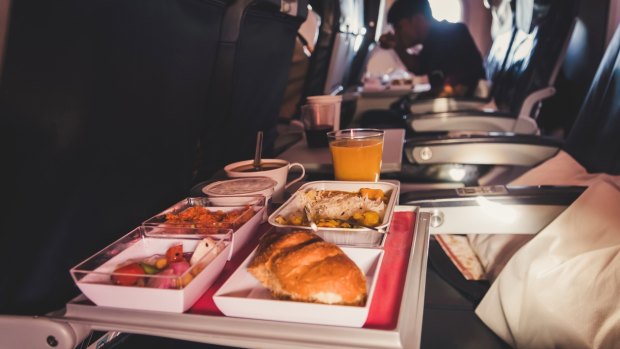This was published 3 years ago
Plane travel and coronavirus (COVID-19): The demise of inflight dining
By Brad Japhe

Throughout economy cabins, food and drink programs have largely ceased altogether. Credit: iStock
In-flight dining never has really been desirable. But in the age of coronavirus, it's downright dangerous.
In response, major airlines, including Australia's, have drastically altered their food and drink programs. Throughout economy cabins, they have largely ceased altogether. The beverage cart has been replaced by a bottle of water plopped atop your lap; a single-serve package of sanitiser is the new "tapas" box.
"The well-being of our customers and flight attendants is our highest priority, so in March we changed our food and beverage offerings to limit contact between customers and flight attendants," explains Jill Surdek, the senior vice president of flight service for American Airlines. "We'll continue to listen to customer feedback and work with our flight attendant team to determine when and how we bring back more food and drink offerings."
In other words, the most a passenger should expect is a plastic baggie filled with a couple of cookies and a few more pretzels - for the foreseeable future.
Nobody should be too bent out of shape about the changes. Medical professionals are now virtually unanimous in their assessment that everyone should wear masks while confined in the friendly skies. And maintaining it over your mouth is a challenge while stuffing stroopwafels down your throat. The greater risk, though, isn't so much from mealtime as it is from shared surfaces.
"Say you have an infected passenger in Row 1A who talks loudly or coughs and spreads droplets onto the beverage cart - it would become a vector," explains Shmuel Shoham, an associate professor of medicine at Johns Hopkins School of Medicine. "Even with the gloved hands of flight attendants, the surface presents the threat of secondary transmission."
That particular risk swayed airlines to temporarily suspend alcohol purchases. It wasn't the act of drinking itself that posed the hazard so much as how it was dispensed.
"We removed all buy-on-board products to remove touchpoints of flight attendants having to take credit cards," explained Maddie King, a spokeswoman for United Airlines, which implemented the policy on March 29. "We still have prepackaged wines and beer available in premium cabins."
The legacy carrier also continues to offer full meals to its first-class passengers, but only on transcontinental routes between San Francisco and Newark, San Francisco and Boston, and Los Angeles and Newark. Foil-wrapped food is delivered individually by the attendant, forgoing the cart. And even then, Shoham advises sanitising your hands after unwrapping it. "Alcohol gels have proven largely effective in combating covid," he said.
Safety considerations aside, the new airline practices are also an extension of a decades-long trend wherein commercial flying has evolved from esteemed luxury to practical utility. The pandemic has merely accelerated that action.
In 2001, American and United each outlaid an average of $US8 ($A11.60) per person for food, according to Department of Transportation statistics. Less than two decades later, that number has slipped by more than 25 per cent. It's easy to imagine a scenario where extreme minimalism becomes the working model moving forward - yet another inconvenient thread in the daunting new normal that continues to weave itself.
Given the trend, now is as good a time as any to consider a personalised approach to provisions. Kat Odell has supplied her own for years. The food writer and author recently had to relocate for work from Tulum, Mexico, to Savannah, Ga. She hardly noticed the new protocols during her flights.
"I feel like it just doesn't impact me at all since I don't ever eat the food, anyway," she notes. "I've always brought my own meals onboard. But if I have to eat something served to me, I'll usually only go with vegetables - or just eat cheese."
And in recent years, many domestic terminals have observed a sizeable uptick in the presence of airside gourmet venues. In-flight dining is increasingly transforming into bring-on-board dining. Home-sourced condiments can also come through in a pinch. Odell shuttles through the airport with TSA-friendly sizes of hot sauce, "to spike anything that's vaguely edible," she says.
Spiking your soft drink, however, is more of an issue. Though FAA regulations technically do allow for a passenger to bring booze aboard a plane for the express purposes of a flight attendant serving it to them, virtually all carriers disavow the practice as a matter of company policy.
"We do not allow customers to bring their own alcohol on board," King says of United's guidelines.
"We haven't announced a date for alcohol to return yet, but our teams are continuously evaluating," adds a Delta spokesperson.
When it comes to meals, at least, there's little to lose by taking matters into your own hands. Just make sure you've properly sanitised them first.
The Washington Post
See also: Should you be wearing a mask on a plane? Some experts say no
See also: Masks on, seats full: Our reporter flies the Sydney-Melbourne route
Send us your travel-related tips, opinions and experiences.
Letters may be edited for space, legal or other reasons. Preference will be given to letters of 50-100 words or less. Include your full name and suburb. Email us at travellerletters@traveller.com.au
Keep your travel dreams alive! Share your most inspirational travel photos and stories with us on Instagram and Twitter using the hashtag #travelleraudream
Sign up for the Traveller Deals newsletter
Get exclusive travel deals delivered straight to your inbox. Sign up now.